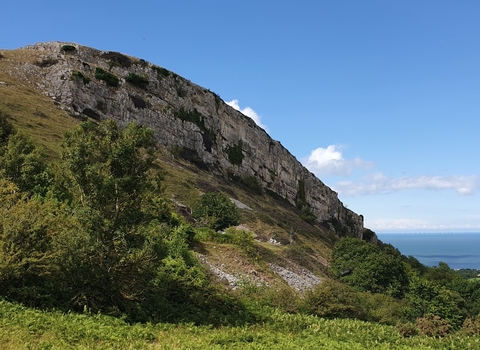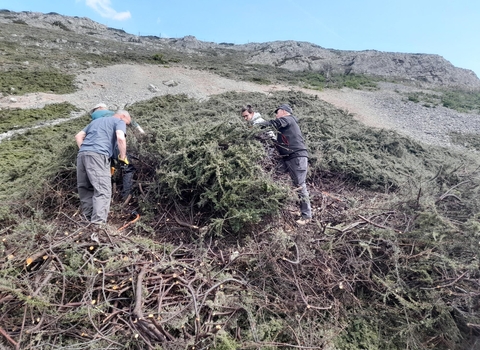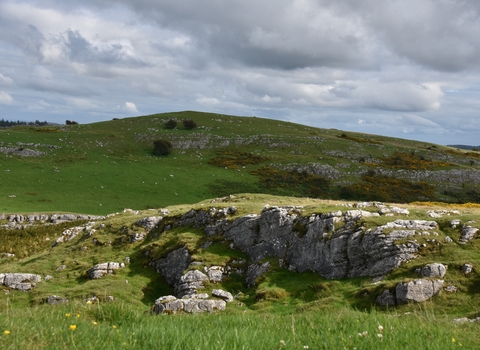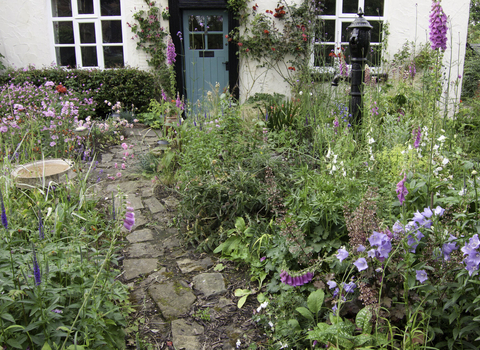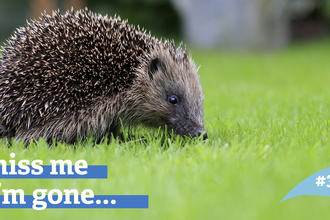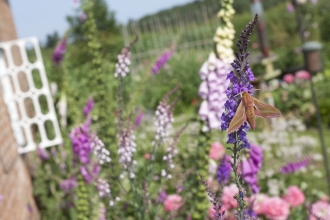Helpwch i ddiogelu glaswelltiroedd calchfaen bregus yng Ngogledd Cymru
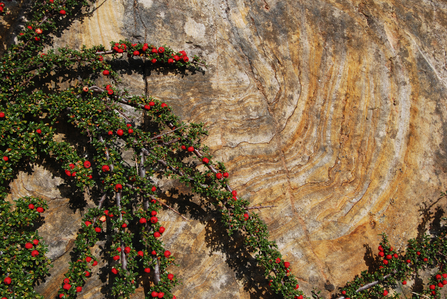
Cotoneaster © Lin Cummins
Ymunwch â ni i helpu i achub ein glaswelltiroedd calchfaen sydd dan fygythiad rhag creigafal estron ymledol. Wedi’i gludo i’r DU yn y 19eg ganrif fel planhigyn gardd, mae bellach wedi’i nodi ymhlith y deg rhywogaeth uchaf sy’n cael effaith negyddol ar safleoedd dan warchodaeth yng Nghymru.
Os na chaiff ei reoli, gall achosi newid parhaol i'n tirweddau lleol gan gael effeithiau dinistriol ar fywyd gwyllt. Mae aeron yn cael eu gwasgaru'n hawdd gan adar sy'n achosi i greigafal ymledu'n gynyddol, am y rheswm yma, mae'n rhaid i ni weithredu nawr!

Limestone grassland ©Philip Precey
Pam ydym ni eisiau gwarchod glaswelltiroedd calchfaen?
Wrth i'r dyddiau fynd yn hirach, dylai glaswelltiroedd calchfaen fod yn gyforiog o liw. Casgliadau helaeth o flodau yn cynnwys y clafrllys bach, plucen felen, ysgallen Siarl, y cor-rosyn a’r bwrned. Bydd tegeirianau cain y wenynen a bera yn cael eu harddangos ochr yn ochr â theim, ysgall di-goes a’r bengaled. Bydd digonedd o löynnod byw, gan gynnwys y gweirlöyn cleisiog, yr argws brown a’r glesyn serennog, yn ymweld am eu ffynhonnell gyfoethog o neithdar.
Yn anffodus, nid yw hyn yn wir am lawer o’n glaswelltiroedd calchfaen. Mae blodau a fyddai, ar un adeg, wedi bod yn eu blodau’n llawn wedi cael eu mygu a'u trechu gan greigafal, gan reoli’r ardaloedd eang o laswelltir a oedd unwaith yn ffafriol. Yn anffodus, mae 90% o’n glaswelltiroedd lled-naturiol wedi prinhau ers yr 20fed ganrif, ac mae’r ardaloedd sydd ar ôl bellach yn aml yn fach o ran maint ac yn dameidiog iawn, gan gael effeithiau dinistriol ar ein bywyd gwyllt lleol. Er mwyn helpu i warchod ein cynefinoedd hoff, rhaid i ni weithredu dros fyd natur.
Rydyn ni’n credu y byddai glaswelltiroedd calchfaen yn diflannu o’n tirweddau yn golled enfawr, a gall cael pobl i ymwneud â’u gwarchod yn lleol fod o fudd gwirioneddol – i unigolion, cymunedau yn ogystal â’n bywyd gwyllt!
Beth rydyn ni'n ei wneud?
Mae Ymddiriedolaeth Natur Gogledd Cymru wedi derbyn grant Cronfa Dreftadaeth y Rhwydwaith Natur i gyflwyno’r prosiect Adfer Glaswelltiroedd Calchfaen. Rydym yn gyffrous i barhau â gwaith gwych y gwirfoddolwyr a’r partneriaid sy'n ymwneud â phrosiect Rheoli Creigafal Gogledd Cymru i reoli cael gwared ar greigafal.
Nod y prosiect yw;
• Cynnal arolwg pellach o ledaeniad a helaethrwydd creigafal ar draws Gogledd Cymru
• Blaenoriaethu pum safle dan warchodaeth sydd angen eu rheoli fwyaf
• Adfer glaswelltir calchfaen ar ôl trin creigafal
• Codi ymwybyddiaeth o effaith creigafal ar dreftadaeth naturiol trwy deithiau cerdded sain tywys
North Wales Cotoneaster Control (https://www.youtube.com/watch?v=fslA8HDtMa0)
North Wales Cotoneaster Control
Ymunwch â Hannah, ein Swyddog Prosiect Adfer Glaswelltiroedd Calchfaen, i archwilio sut mae prosiect rheoli creigafal Gogledd Cymru wedi gadael gwaddol ar gyfer ein cenhadaeth barhaus.
Dyma ganllaw defnyddiol i "Garddio heb blanhigion ymledol niweidiol" gan gynnwys llwyni yn lle creigafal (tudalen 30) i gadw’ch gardd yn fwrlwm o fywyd.
Mae Ysgrifenyddiaeth Rhywogaethau Estron Prydain Fawr wedi creu cynnwys defnyddiol - "Tips for gardeners to Be Plant Wise" - ymgyrch i helpu i ddewis beth i'w dyfu, sut i atal ymlediad planhigion ymledol a chompostio'n ofalus ar ôl eu symud.

®Lottery Heritage Fund in partnership with Welsh Government
Mae’r prosiect hwn yn cael ei gyllido gan y Rhaglen Rhwydweithiau Natur.
Mae’n cael ei gyflwyno gan y Gronfa Dreftadaeth, ar ran Llywodraeth Cymru.

